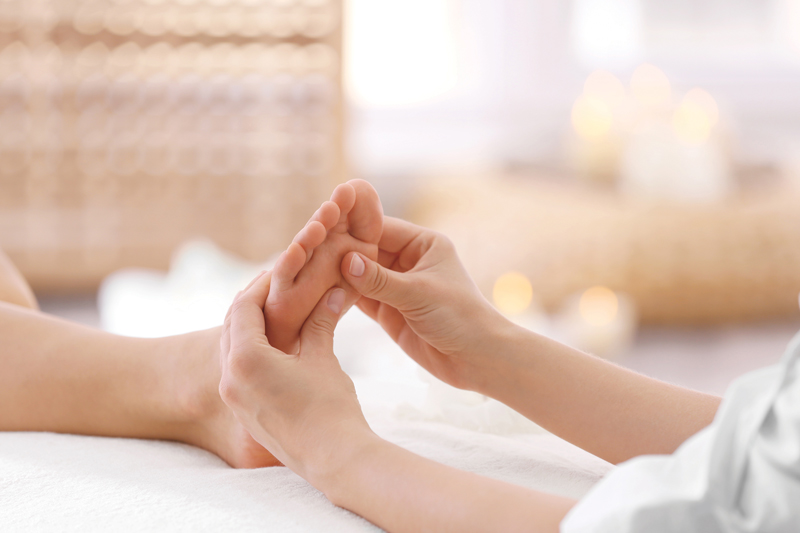Natural therapies evoke natural responses for the enrichment of mind, body and “sole.” With that thought in mind, I invite you to relax, take off your shoes, feel the ground under your feet and discover it’s time to step into your life with Reflex-“ahhh”-logy. You are about to discover that a change in life is only two feet away!
Since the beginning of time, human beings have searched for new ways to maintain health, vibrancy and to ward off disease and the effects of accumulating stress on the body. Each generation has had to deal with an increasingly complex and stressful social environment. Stress has become synonymous with everyday life. Some stress is beneficial. It motivates growth, learning and change. On the other hand, too much stress could cause you to suffer not only psychologically but physically as well. Many doctors today accept that about 75% of all illnesses they treat stem from stress related conditions. Tension and stress cause the muscles in the body to contract. Constriction of our energy flow within the body prevents it from functioning normally and effectively. Too much stress undermines your immune system and general health and leads to a myriad of health problems.
As we are now in the new millennium, many people are being drawn to ancient healing traditions. People are now discovering that the solution to many of their health concerns may be right under their feet. Our feet provide a window of communication to our entire body. Our feet help our body to adjust and change to meet the demands of the day. Reflexology can help locate stress cues and give you the tools to help relax the stress thus impacting your health. You can take control of your health by tuning in to what your feet have to say. After all, our feet don’t lie.
The origins of Reflexology reach back to the year 2330 B.C. in ancient Egypt as evidenced by inscriptions found in a physician’s tomb in Saqqara, Egypt. Over several centuries, reflexology was introduced to the West by an American Ear, Nose and Throat surgeon. Fascinatingly enough, this surgeon has a Nutmeg State connection. In 1913, Dr. William Fitzgerald was the head of the ENT Department at St. Francis Hospital located in Hartford. He observed that pressure on specific parts of the body could have an effect on a related area. He divided the body into 10 longitudinal zones, ending in the fingers and toes. He concluded that pressure in one part of a zone affects other parts within this zone. This became known as “Zone Therapy.”
It wasn’t until the early 1930’s Eunice Ingham re-defined this term to “Foot Reflexology.” Eunice took the anatomical structures of the body and mapped them out in each correlating zone ending on the soles of the feet and palms of the hands. Reflexology is not to be confused with massage. Reflexology works directly with our central nervous system. It is primarily applied to our feet since we have over 7000 nerve endings on the soles of our feet. This makes them quite sensitive and responsive to the sensory input of reflexology. These reflex points act as small “mirrors” that reflect our entire body and all its parts.
By using specific, patterned, alternating movements and pressure of the fingers and hands, the energy blockages can be detected through the experience of sensitivity or through the presence of “gritty areas” or crystal deposits. These occur in the part of the foot or hand that relates to the part of the body that is imbalanced. When pressure is applied, predictable, positive changes occur in the body. Upon completion of a session all of the systems of the body have been stimulated. It is through this stimulation and encouraging the release of toxins from the body that reflexology encourages the healing process to begin. It provides the body with renewed physical and emotional strength.
Reflexology is not a cure for any condition nor is it intended to replace conventional medical treatment. In order to achieve a state of wellbeing, we need to pay attention to our bodies’ basic needs. We need to have a change of attitude to the factors in our lives that are creating negative stress reactions. A part of a stress management routine could include a relaxing reflexology session. It is an excellent antidote to stress and can produce deep therapeutic relaxation. Reflexology can help stimulate the brain, relieve muscle pain and headaches, increase energy level, and relieve tension and stress. It can help with better elimination of waste products, improvement of blood circulation, and enhance and balance the body’s functioning. It is also a beneficial aid for those undergoing chemotherapy treatments. Take the next step and discover the amazing world of Reflexology!
Lori Massey, ARCB Reflexologist has been practicing the healing art of reflexology for the past 16 years. She is trained in several methods of reflexology which include The Universal Method of South Africa, Rwo Shur Chinese Reflexology and The Laura Norman Method and is nationally certified by the American Reflexology Certification Board. Reflexology is available for the Feet, Hands, and Face. Services offered at Salt of the Earth Spa in Woodbury.
